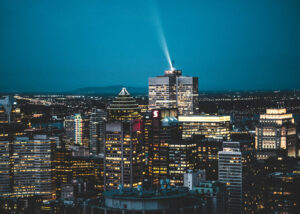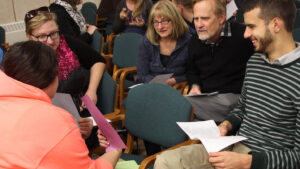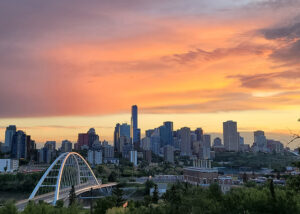An estimated two billion people around the world tuned in on Friday, April 29, to watch the wedding of Prince William, grandson of Queen Elizabeth II, and Catherine Middleton at Westminster Abbey, a ceremony infused with British pageantry and steeped in elements of Anglicanism — past, present and future.
The streets of London bulged with thousands of well-wishers, some who’d camped for days to ensure a glimpse of the happy couple, named just before the wedding as the Duke and Duchess of Cambridge, Episcopal News Service reports.
Inside the abbey, the Very Rev. John Hall, dean of Westminster, conducted the service according to a 1966 version of the liturgy of matrimony from the Anglican Book of Common Prayer, while Archbishop of Canterbury Rowan Williams, as head of the officially established Church of England, presided over the royal wedding and solemnized the marriage.
The Anglican leaders of Scotland, Ireland and Wales were among the 2,000 guests attending the ceremony, alongside representatives from other faith traditions, members of the British and foreign royal families, international dignitaries, members of the U.K. Parliament, and celebrities such as rock star Sir Elton John.
The Most Rev. David Chillingworth, primus of the Scottish Episcopal Church, said in a statement that it was “a great privilege” to attend the royal wedding. “Every wedding is a moment of hope and trust as people commit themselves to one another and to the unknown future.”
Bishop Richard Chartres of the Diocese of London, a personal friend and mentor to the royal family and dean of Her Majesty’s Chapels Royal, delivered the sermon. “This is a joyful day. It is good that people in every continent are able to share in these celebrations, because this is as every wedding day should be — a day of hope,” said Chartres.
Chartres, who confirmed Middleton into the Church of England at a private ceremony in March, said: “Marriage should transform as husband and wife make one another their work of art. It is possible to transform as long as we don’t harbor ambitions to reform our partners … Each must give the other space and freedom.”
In a message released before the wedding, Williams said he has been “very struck” by the way the couple approached the event. “They’ve had a very simple, very direct picture of what really matters about this event … I think that they have a clear sense of what they believe they’re responsible to. They’re responsible to the whole society; responsible to God for their relationship,” he said.
In a message printed at the start of the official wedding program, the couple said: “We are both so delighted that you are able to join us in celebrating what we hope will be one of the happiest days of our lives. The affection shown to us by so many people during our engagement has been incredibly moving, and has touched us both deeply.”
William is second in line to the British throne, after his father, Prince Charles, the Prince of Wales. The British monarch is also supreme governor of the Church of England.
The wedding ceremony included a strong ecumenical and interfaith presence, with faith leaders from the Buddhist, Jain, Jewish, Muslim and Sikh communities in the United Kingdom, as well as representatives from the Roman Catholic, Presbyterian, Greek Orthodox and Zoroastrian traditions.
Choral music at the service was performed by the combined choirs of Westminster Abbey and Her Majesty’s Chapel Royal, St. James’s Palace. Voices, trumpets and the London Chamber Orchestra combined to usher in the radiant bride to the majestic sounds of C. Hubert Parry’s well-known anthem, “I Was Glad,” composed for the coronation of Edward VII, Prince William’s three-times great grandfather.
Hymns during the ceremony were “Guide Me O Thou Great Redeemer”; “Love Divine, All Loves Excelling”; and “And Did Those Feet in Ancient Time.” Another musical highlight was a new anthem by British contemporary composer John Rutter, “This is the day which the Lord hath made,” commissioned by the dean and chapter of Westminster Abbey for the occasion.
Westminster Abbey has been a historic centerpiece for royal celebrations and ceremonies, dating back to 1066, the year that saw the coronations of Harold II and William the Conqueror. The abbey is known as a “royal peculiar,” a place of worship that falls directly under the jurisdiction of the British monarch, rather than a bishop.
As the streets of London came alive with celebrations, the royal wedding festivities stretched far beyond Westminster Abbey. Anglican and Episcopal churches around the world that trace their origins to the Church of England held events and services to mark the occasion.
“It’s a celebration of our roots and extends our identity to a larger group in England and across the world,” said the Rev. David Klutterman, rector of the Episcopal Church of St. John the Baptist in Wausau, Wisconsin, according to Religion News Service. The parish planned to serve tea to guests at a wedding-viewing and fundraising party. “If Anglicans can’t have high tea to celebrate the royal wedding, who can?” Klutterman said.
Parishioners at Grace Anglican Church in Brantford, Ontario, hosted their own royal festivities, complete with a free continental breakfast and traditional wedding bunting, RNS reported.
“Lent [is] over, so it will be time for a party,” said the church’s rector, the Rev. David M. Ponting, before the wedding, adding that the church invited people to dress up as their favorite royal or British celebrity. “I haven’t decided if I will be the Archbishop of Canterbury or Elton John,” he joked.
–April 29, 2011







Leave a Reply
You must be logged in to post a comment.